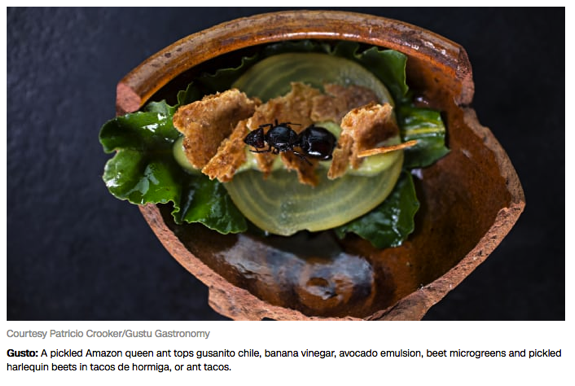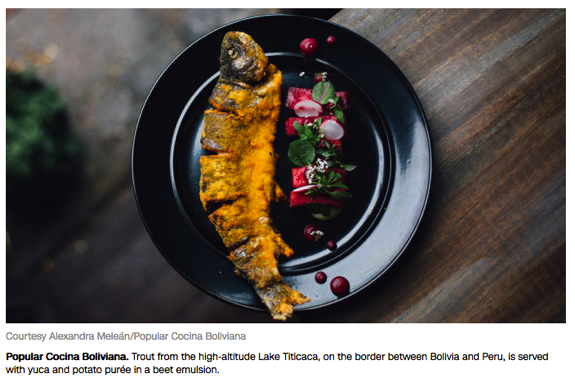
Bolivian chefs are trading colonial cuisine for national pride
August 29, 2018 - CNN.com
Jen Rose Smith, CNN
La Paz, Bolivia (CNN) — Midway through a 17-course tasting menu at Gustu, a La Paz restaurant where dinner and drinks for two could cost more than many Bolivians could afford, a plate arrived bearing three translucent cubes of ceviche.
The chewy, sweet-tasting meat was lagarto, a reptile known in English as a yacare caiman.
Before arriving in Gustu's gleaming kitchen, which is heated against the high-altitude chill of La Paz, the caiman swam and basked in the steaming rainforest of the Bolivian Amazon. When fed on piranhas and the occasional capybara, the reptiles can grow to almost 10 feet long -- and they're not exactly a mainstay of elegant dining rooms.
High cuisine's peasant revolution
In elite restaurants in destinations around the world, though, chefs have long been rethinking the basic elements of high cuisine, stocking their kitchens with organ meats, foraged plants and gnarled, unlovely roots.
At Los Angeles' Animal, elegant small plates feature pig ears and marrow bones, once the stuff of peasant kitchens. In New York's Blue Hill at Stone Barns, a $258 tasting menu might include stinging nettles, invasive knotweed and sassafras buds from the surrounding forest. British chef Fergus Henderson has helped bring "nose to tail" cooking to fine dining in the United Kingdom, and a recent summer menu at his St. John restaurant in London listed pig's tongue, trotters and spleen among the options.
For some chefs, it's a return to authenticity or sustainability. For others, it's a question of flavor.
But for a handful of Bolivia's young, ambitious chefs, Amazonian caiman, altiplano potatoes and fish from Lake Titicaca have a revolutionary appeal.
Post-colonial kitchens

The country, which is majority indigenous, was a Spanish colony for almost 300 years, until 1825. It's a history that still resonates.
"We always grew up thinking that everything good came from outside of Bolivia," said Gustu's 28-year-old head chef Marsia Taha. "Now we're looking at what we have here."
Taha, a La Paz native who's worked in the Gustu kitchen since the restaurant opened in 2013, has found the job to be a lesson not just in cooking techniques, but also in botany and wildlife biology.
"Every single month, someone comes into the restaurant with something I've never seen and never heard of, and I have to ask my scientist friends: 'Can I eat this?'"
Foodie philanthropy

At first glance, Taha's culinary journey parallels the original vision of Gustu owner Claus Meyer, co-founder of the acclaimed Danish restaurant NOMA.
Looking for a new project, Danish-born Meyer combed the globe for an impoverished country where an innovative restaurant could be an economic boon, but also one that would be rich with "undiscovered" ingredients.
He found that in Bolivia, one of the poorest countries in Latin America. With a landscape that goes from snowy Andean peaks to Amazonian rainforest, the country's varied ecosystems and biodiversity produce a remarkable variety of foods.
The country appealed, Meyer said speaking with a reporter from The Guardian newspaper, in part because "you have access to a large diversity of products, unknown to foodies." Even as he celebrated Bolivia's natural resources, Meyer's comments sometimes seemed to dismiss the country's own culinary traditions.
"Bolivia may have the most interesting and unexplored biodiversity in the world," said Meyer, suggesting that his work in Bolivia could be transformative, and that he'd seek out young people with few opportunities.
"We would be the catalysts, in opening their eyes to the enormous potential in the country," Meyer said to Danish reporter Julian Isherwood.
Outsider chefs
When Gustu opened to the public in 2013, international coverage by food writers was incredulous.
With thin air, cold nights and grinding poverty, La Paz seemed a shocking choice for a star restauranteur. In a skeptical comment that echoed a chorus of voices largely ignorant of Bolivia's food traditions, Bloomberg writer Ryan Sutton wrote that "no one's flying to La Paz to eat llama cooked in a vacuum-sealed bag."
According Sumaya Prado, who handles communications for the restaurant, Gustu's arrival in Bolivia brought more shrugs than fanfare among locals. "It was a crazy gringo restaurant in Latin America's poorest country."
But since the restaurant opened under the direction of Danish chef Kamilla Seidler, Gustu's helped transform the La Paz food scene, starting by shaking up local ideas about what qualifies as high cuisine by putting indigenous ingredients front and center.
And unlike in those early years, the chefs currently making headlines are Bolivian.
Meanwhile, Meyer's talk of "discovery" -- which one local chef accused of colonial undertones -- has given way to a high-flavored celebration of Bolivia's heritage.
Cooking national pride

Under Socialist president Evo Morales, the first indigenous president in Latin America, Bolivia is simmering with a new found pride in local traditions.
"In 2006, when Evo Morales entered the presidency, there was a big change," said chef Juan Pablo Reyes Aguilar of Popular Cocina Boliviana, which opened in November 2017. "There was much more pride in being Bolivian, and it resonated in art, architecture, painting, design and food."
The tiny restaurant was founded by a trio of friends -- Aguilar joined forces with chef Diego Rodas and manager Alexandra Meleán -- who met at the La Paz restaurant ONA, where they felt frustrated by the limitations of cooking high-end cuisine that catered to foreigners. (Set in the elegant Atix hotel, whose Bolivian-inspired façade was conceived by a pair of New York-based design studios, ONA blends Bolivian flavors with more international cooking.)
"It was like: 'You can be Bolivian, but not too Bolivian,'" said Rodas.
Gustu chef Marsia Taha, along with the owners of Popular Cocina Boliviana described that attitude as coming from years of valuing imported goods over local products and cooking techniques.
"In the end, chefs want to show what they've learned in foreign countries or show off expensive, imported foods," said Aguilar.
"They go to Spain, see things over there and assume it's better. But when you do your own thing, you'll have more confidence, and you'll have more pride in what you do if you do it well. That's what we want to do at Popular."
Celebrating what's local

That confidence infuses their tiny, second-floor dining room, where every course is a celebration of Bolivian culture. A dish of tender, smoked chicken arrives in a nest of grass, like those used to wrap the country cheese sold in local markets.
Bolivian beer and wine are poured alongside courses that range from classic anticuchos -- grilled cow heart served with potatoes from the high-altitude altiplano -- to baked trout pulled from Lake Titicaca.
Even the most traditional dishes feature unexpected twists drawn from the chefs' experience in internationally influenced kitchens.
And the new wave of Bolivian food nativism goes beyond fine dining.
Founded in 2015 by La Paz local Sukko Stach, Antigua Miami is just downstairs from Popular, and it's one of a few La Paz cafes to feature locally-grown and roasted beans. Like the young chefs in La Paz, Stach is working to keep some of Bolivia's finest products inside the country, both at Antigua Miami and at Hay Pan, a wine bar that he founded to highlight local vintners.
"The best coffee and the best wines leave the country before they're even available to buy here," said Stach, who travels to Bolivia's grape- and coffee-growing regions to find sources for his coffee shop and wine bar.
The steady flow of high-quality goods leaving Bolivia echoes the country's almost three centuries under Spanish rule, when ships laden with local silver, gold and tin sailed from South America to Spain, enriching colonial rulers at the expense of locals. Now, exported Bolivian wine lands on tables in Japan, Europe and the United States. And for Stach, purchasing a share of each year's best wines can require an unconventional approach.
"I talk to the farmers and winemakers," he said, "and then I'll have to go to the bus station to wait for one crate that arrives from the countryside."
Who's at the table?

Competing with international markets means Stach pays international prices, so a cappuccino at Antigua Miami can cost as much as a coffee in downtown San Francisco.
As with the meals at Gustu, that places his menu beyond the reach of many Bolivians. It's an irony that's common in the high-end La Paz food scene. Even as Stach works to keep good-quality coffee and fine wine within Bolivia, many of his customers are foreigners who could have purchased those products at home.
At Gustu, Sumaya Prado estimates that when the restaurant opened, 80% of guests were foreigners. Now, Prado says, as the restaurant has become a source of pride for Bolivians, the balance has finally shifted a little -- to 60% foreigners, 40% locals.
The owners of Popular Cocina Boliviana designed their restaurant's schedule and menu in the hopes that they could buck the trend, starting by opening in a downtown business district with plenty of local office workers.
They only serve lunch, which is traditionally the main meal of the day in Bolivia, and a three-course menu costs just 60 Bolivianos, less than US $9. At first, they served a mostly local crowd, but as the months have gone by, Bolivian diners are slowly giving way to foreign visitors.
Shortly after opening, glowing reviews made them more and more prominent online. They hit #1 on TripAdvisor in the months following their opening, and the restaurant still ranks high among the hundreds of La Paz restaurants listed on the site.
"I don't know if the TripAdvisor thing is good or bad," said Alexandra Meleán, who manages a line of hopeful visitors who arrive before the restaurant opens, a crowd of mostly foreigners who have discovered the restaurant online, "but now it means that Bolivians on their lunch breaks don't have time to wait for a table."
"On a good day," Meleán said, "we're 50-50."
---------------------------
- Gustu, Avenida Costanera 10, La Paz, Bolivia; +591 221 17491
- Popular Cocina Boliviana, Calle Murillo 826, La Paz, Bolivia; +591 656 13649
- Antigua Miami, Calle Murillo 826, La Paz, Bolivia
- Hay Pan, Calle Murillo 764, La Paz, Bolivia; +591 772 57455
Jen Rose Smith is a freelance writer and award-winning guidebook author whose work explores travel, adventure and food. She's currently living on the road, with a mountainous 2018 itinerary that goes from the Andes of South America to the foothills of the Spanish Pyrenees. Read more of her work at jenrosesmith.com